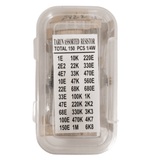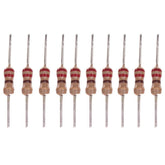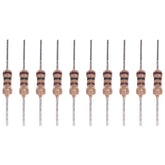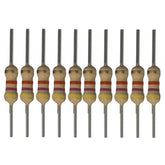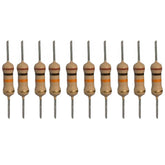Types of resistors in electronics
Summary
Discover the essential world of resistors in electronics with our comprehensive blog. From the importance of resistors in electronic circuits to an exploration of linear and non-linear resistor types, delve into the vast array of resistors available. Uncover fundamental parameters, practical applications, and get a glimpse into future resistor trends. Whether you're a seasoned electronics enthusiast or just starting, this blog offers valuable insights. Don't miss out on understanding the backbone of electronic components. Read on to power up your knowledge!
Introduction
Resistors are ubiquitous electrical components found in all kinds of electronic circuits and systems. They are passive devices that limit and control the flow of electric current through them. The level of resistance is measured in Ohms, represented by the Greek symbol Ω. Resistors convert surplus electrical energy into heat, allowing control of voltages, adjustment of signal levels, limiting of current to prevent damage and sensing of parameters like temperature, light or position. Let's take a deeper dive into the importance, properties, types and applications of the humble, yet versatile resistor.

Why are Resistors Important?
Imagine an electronic circuit as a complex highway system for electric current flow. Without traffic rules, signals and speed limits, there would be accidents everywhere! Similarly, resistors provide the 'rules of the road' for currents in a circuit. Some key functions of resistors in circuits include:
- Current Limiting: Resistors restrict current flow to safe levels, preventing damage to fragile components. Inrush current is limited when circuits are first powered on.
- Voltage Drops: The resistance causes a precise voltage drop across a resistor following Ohm's law. This helps generate stable voltage levels required for operation of electronic components.
- Energy Dissipation: Excess electrical energy is dissipated as heat through resistors. High power resistors are used for dynamic braking across motors.
- Sensing: Thermistors, photoresistors and other variants change resistance in response to temperature, light or position changes. This allows parameter measurement.
- Signal Mixing: Combining voltage drops across series/parallel resistors enables signals to be attenuated, filtered and smoothed to required levels.
- Circuit Protection: Current flow is limited by resistors during accidental short circuits or faulty conditions. Fusible resistor links open when overheated to safeguard circuits.
- Voltage Division: Voltage dividers made of a pair of resistors connected in series generate lower voltages from higher supply voltages.

Clearly, resistors provide critical functions like current limiting, voltage regulation, sensing and circuit protection in electronic systems. Next, let's examine the different types of resistors available.
Types of Linear Resistors
Linear resistors have a fixed resistance value in Ohms that remains constant over a wide range of operating voltages and currents. The main classifications are:
1. Fixed Resistors:
These have a preset resistance value that does not change. They provide precision and stability in circuits. Common types include:
- Wire-wound Resistors: A resistive wire, like nichrome, is wound around an insulating core made of ceramic, plastic or fiberglass. The resistance value depends on the wire material, its length and thickness. They handle high power levels due to better heat dissipation.
- Thin Film Resistors: These are made by depositing a metallic or ceramic film of uniform thickness on an insulating substrate, typically alumina. Precise photolithographic processes are used to achieve very low tolerances.
- Thick Film Resistors: These screen print a mixture of glass frit, metals and binders which is fired at high temperature on a ceramic substrate to form the resistive element. They achieve moderate performance at lower costs.
- Carbon Composition Resistors: Finely powdered carbon or graphite is mixed with a filler and insulating binder which is molded into a cylindrical shape with lead wires. They are inexpensive but noisy.
- Carbon Film Resistors: A layer of carbon or graphite film is deposited on a ceramic rod or substrate and spiral cut for adjusting resistance. They achieve better stability than carbon composition resistors.
2. Variable Resistors:
These allow adjustment of resistance values over a designed operating range. Examples include:
- Potentiometers: A movable wiper slides over a resistive track tapped between two terminals to vary resistance between the wiper and each terminal. They act as adjustable voltage dividers.
- Rheostats: The wiper slides over a single resistive track to vary overall resistance between two terminals. Rheostats adjust current flow in devices like motors.
- Trimmer Resistors: These are preset variable resistors set to a desired value during circuit calibration using mechanical adjustment of screw threads or sliding contacts.

Types of Non-Linear Resistors
Non-linear resistors have a variable resistance value depending on applied voltage, current, temperature or other external factors. They are useful for functions like surge protection, sensing and measurement. Major types include:
- Thermistors: Ceramic semiconductors that exhibit large resistance changes with temperature fluctuations. Two types are:
1) NTC - Resistance decreases with increase in temperature. Used for temperature measurement, compensation circuits and current limiting.
2) PTC - Resistance increases sharply above threshold temperature due to crystalline effects. Used as resettable fuses, overcurrent and overtemperature protection devices.
- Varistors: Ceramics containing zinc oxide that display highly non-linear current-voltage profile. Below threshold voltage, resistance is very high. Above it, resistance drops significantly to absorb voltage surges. Used for surge suppression.
- Photoresistors: Light depending resistors made from cadmium sulphide, cadmium selenide or other semiconductors that exhibit reduced resistance with increasing illumination. Used for light sensing, meters and switching applications.
- Magnetoresistors: Made from semiconductor materials like indium antimonide or gallium arsenide. Resistance changes based on strength of applied magnetic field. Allows sensing position, speed and magnetic field strength.
- Gas discharge tube: Contains two electrodes in a gas filled glass envelope. Below striking voltage, it acts as an open circuit. When breakdown voltage is exceeded, gas ionizes lowering resistance significantly. Used for surge protection.
Other Types of Resistors
Beyond the common fixed, variable and non-linear resistors, some other special varieties of resistors cater to specific applications:
- High Power Resistors: Wire wound, metal oxide or ceramic resistors rated for dissipating over 5 watts of power without overheating. Used in motor controls, power supplies, etc.
- High Precision Resistors: Ultra-precision resistors with tolerance better than 0.005%. Thin film types used in metrology and calibration devices demanding very high accuracy.
- Tapped Resistors: Have multiple taps that allow selection of different resistance values by connecting terminals. Used in audio amplifier controls and bridged measurement circuits.
- Shunt Resistors: Ultra low resistance current sense resistors through which the circuit current flows. By measuring voltage across them, the circuit current can be accurately determined.
- Fusible Resistors: Wire wound power resistors with calibrated fusing characteristics that acts as a fuse by intentionally burning open under overload conditions. Used for circuit protection.
Fundamental Resistor Parameters
To select and apply the right kind of resistor in applications, one must understand their key specifications:
- Resistance Value in Ohms: Available from fractions of an ohm to hundreds of megaohms. Tolerances range from ±1% down to ±0.005% for precision resistors.
- Power Rating in Watts: Maximum power a resistor can safely dissipate without getting damaged. Rating depends on its mass and surface area for heat dissipation.
- Voltage Rating: Maximum voltage that can be applied continuously across the resistor terminals.
- Temperature Coefficient: Indicates the resistance change per degree change in temperature. Improves circuit performance over temperature.
- Tolerance: Specifies maximum deviation from nominal marked resistance value. Closer tolerances improve circuit precision.
- Noise: Resistors generate thermal noise and current noise depending on materials and construction. Low noise is critical for signal processing circuits.
- TCR (Temperature Coefficient of Resistance): Quantitative indicator of resistance change versus temperature. Improves circuit stability over temperature range.
Practical Resistor Applications
Resistors perform a multitude of critical functions in diverse electrical and electronic systems through appropriate selection and application:

- Voltage Divider Circuits: Pair of resistors in series across voltage source divides it into fractions determined by Ohm's law. Used for measurement and to supply reduced voltages.
- Current Sensing: Shunt resistors convert measured current to proportional voltage. Allows currents to be monitored indirectly. Used in meters, relays and protection circuits.
- Waveform Clipping and Clamping: Diode clipping or Zener clamping circuits using resistor-diode combinations modify input signal waveforms. Used in analog signal processing.
- Smoothing and Filtering: Resistor-capacitor RC networks convert pulsating DC into smooth DC and filter out noise from signals. Essential for power supplies and signal conditioning.
- Active Load: Transistor amplifiers need DC load at input and output stages which resistors reliably provide through biasing and collector loads. Sets operating points.
- Timing Circuits: Resistor-capacitor R-C networks produce time delays for applications like timer relays, oscillator circuits and signal debouncing.
- Surge Protection: Varistors or gas discharge tubes connected across supply lines conduct heavily in case of transient voltage spikes, protecting delicate internal electronics from damage.
- Temperature Compensation: NTC and PTC thermistors compensate for variations in voltage, current and other parameters over temperature. Improves stability of circuits.
- Current Limiting: Series resistors in supply lines drop voltage thereby restricting current during initial turn-on or accidental short circuit in downstream electronics. Prevents overcurrent damage.
Resistors enable voltage division, parameter sensing, waveform shaping, timing control, temperature stability and circuit protection in a very wide gamut of electronic systems, making them indispensable components.
Future Resistor Trends
While resistors have been used in electronics for over a century, ongoing research seeks to improve performance and expand applications by exploiting new materials and nanoscale fabrication technologies:
- Printed Resistors: Screen printing of resistive inks on substrates like polyimide, paper and textiles enables integration into flexible electronics and smart fabric or biomedical sensors.
- Thin Film Resistors: Deposition techniques like sputtering allow creating precise and stable resistance films down to nanometer thicknesses with high tolerance. Enables ultra-compact surface mount resistors.
- Metal Foil Resistors: Etched thin metal foils generate less noise and low parasitic effects compared to wire wound and thick film resistors, improving high frequency performance.
- Carbon Nanotube Resistors: Leveraging excellent mechanical and electrical properties of CNTs allows creation of smaller and more energy efficient power resistors and surge suppressors.
- Gallium Nitride Resistors: GaN thermistors leverage wider bandgap of GaN to operate at much higher temperatures approaching 1000°C with lower leakage current compared to silicon thermistors.
Conclusion
Resistors are indispensable components that enable control and measurement of current, generation of precise voltage levels, sensing of temperature and light intensity, protection of delicate circuits and much more. They come in a broad array of types like wire wound, carbon composition, thermistors, varistors etc. tailored for diverse applications. Performance parameters like resistance value, tolerance, power rating and operating temperature range must be carefully matched to application needs. Continued research leveraging newly developed advanced materials and nanofabrication methods promises to enhance the capabilities and applications of resistors further in the future. The ubiquitous resistor, despite its simplicity, shall continue to play a vital role in electrical and electronic systems that empower modern society.



